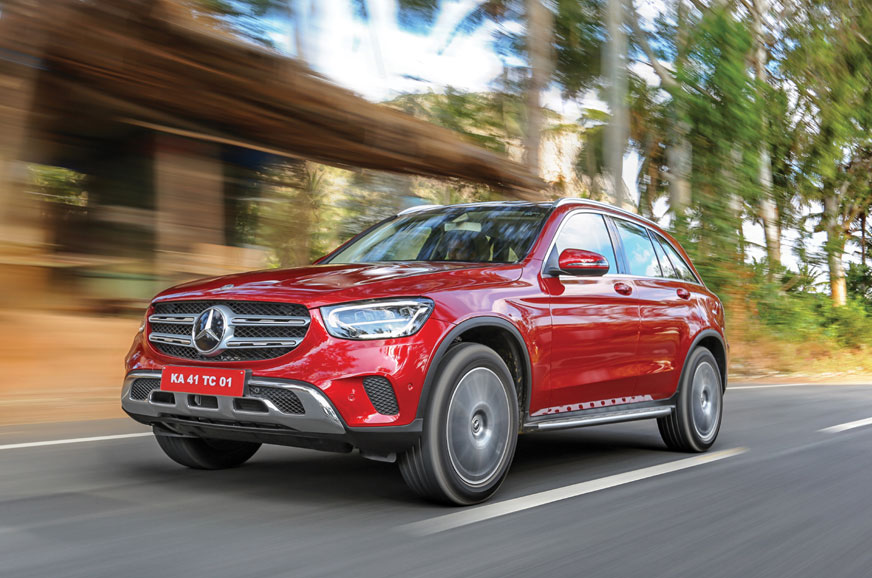
What is it?
It’s the mid-life update for the Mercedes-Benz GLC – the C-class of SUVs, if you will – and as a result, you will notice some similarities between this and the update given to the C-class in September 2018. Like the sedan, this one gets a widescreen-format, 10.25-inch infotainment screen, it gets the new OM654 2.0-litre turbo-diesel engine (BS6-compliant, of course), a few updates on the dashboard, and a wheel size that’s gone up by one inch. Apart from those, however, there are some changes that go beyond what was given to its sedan counterpart.
What’s it like inside?
For one, it’s now a touch interface. This makes things simpler to access, and if you find that a bit distracting on the go, then Mercedes’ clever steering-mounted, mini touchpad system works surprisingly well once you get used to it. Sadly, the click-wheel controller on the centre console has been abandoned in place of a touchpad, which is, frankly, less helpful when you’re driving.
What might be more helpful in time is the new ‘Hey Mercedes’ intelligent voice interface. Now there have been voice-control interfaces before, and even others that have used informal speech, but the MBUX system stands apart, in India at least, because it enlists the help of AI to answer a greater variety of questions, and it does so thanks to mobile data from an onboard e-sim. Yup, the GLC is now a connected car, and that includes the ‘Mercedes Me’ partner app that lets you do the usual host of things – tracking, locking, unlocking, pushing info to the car, vehicle status, and there are also things like an assistance/emergency services hotline built into the car.
What is it like to drive?
The introduction of the OM654 2.0-litre diesel, as ever, is a welcome upgrade from the old 2.1-litre OM651 diesel engine, and that’s not just because it makes 24hp more, at 194hp (strictly speaking, you can’t feel the difference). The first impression is of far greater refinement than before – at start-up and on the move. Power delivery is more linear than before, and you don’t get that same step up in power at about 2,000rpm, but instead, a far smoother delivery of power. The 9-speed automatic remains quite smooth in everyday driving, with only really erratic acceleration throwing it off and causing it to stutter.
More of a revelation is the ride quality of the updated GLC. The suspension has been reworked slightly with the facelift, as it was in the C-class, and this has given Mercedes the confidence to move up from an 18-inch to a 19-inch alloy wheel size. The tyre size is 235/55 R19, and thankfully that means they still have a pretty considerable sidewall height, and so are pretty good at absorbing all but the sharpest of bumps. Body control with this revised suspension is a fair bit tighter, and that hasn’t come at the detriment of comfort either.
Should I buy one?
One of the strengths of the GLC has always been its aggressive pricing, and in order to maintain that positioning after the facelift, Mercedes-Benz made another big change. While the petrol version was previously positioned as the highest-spec GLC, it is now the base model. However, the equipment level is the same as the diesel, at least for now. So how have they done it? For one, they’ve used the lower ‘200’ spec of the 2.0-litre turbo-petrol engine with 197hp and 320Nm, instead of the ‘300’ spec with 245hp and 370Nm. Moreover, it’s two-wheel-drive rather than all-wheel drive, and frankly, we think most buyers won’t mind that one bit.
So while retaining its aggressive price point, the changes to the GLC have done well to bring it back to the front lines, alongside the likes of the X3, Q5 and XC60. It’s still not the most exciting to drive, but it rides significantly better and the new diesel engine, apart from being BS6-compliant, is smoother too. The biggest change, though, is the MBUX infotainment system, which is really among the best in the industry now. Yes, perhaps a few more things could have been added to the equipment list, but that aside, the GLC has done well to catch up to its newer rivals.
from Autocar India https://ift.tt/2sTQkzn
via IFTTT

No comments:
Post a Comment